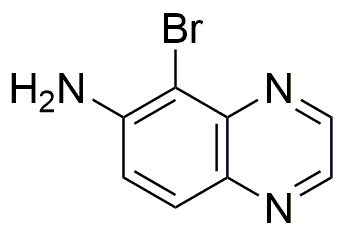6-Amino-5-bromoquinoxaline is widely utilized in research focused on:
- Pharmaceutical Development: This compound serves as a crucial building block in the synthesis of various pharmaceuticals, particularly in developing drugs targeting neurological disorders.
- Antimicrobial Research: Its unique structure allows it to be explored for potential antimicrobial properties, making it a candidate for new treatments against resistant bacterial strains.
- Fluorescent Probes: The compound can be modified to create fluorescent probes used in biological imaging, enhancing visualization techniques in cellular biology.
- Material Science: It is utilized in the development of organic semiconductors, contributing to advancements in electronic devices such as sensors and transistors.
- Biochemical Assays: The compound is employed in various biochemical assays, providing researchers with tools to study enzyme activity and protein interactions.
General Information
Properties
Safety and Regulations
Applications
6-Amino-5-bromoquinoxaline is widely utilized in research focused on:
- Pharmaceutical Development: This compound serves as a crucial building block in the synthesis of various pharmaceuticals, particularly in developing drugs targeting neurological disorders.
- Antimicrobial Research: Its unique structure allows it to be explored for potential antimicrobial properties, making it a candidate for new treatments against resistant bacterial strains.
- Fluorescent Probes: The compound can be modified to create fluorescent probes used in biological imaging, enhancing visualization techniques in cellular biology.
- Material Science: It is utilized in the development of organic semiconductors, contributing to advancements in electronic devices such as sensors and transistors.
- Biochemical Assays: The compound is employed in various biochemical assays, providing researchers with tools to study enzyme activity and protein interactions.
Documents
Safety Data Sheets (SDS)
The SDS provides comprehensive safety information on handling, storage, and disposal of the product.
Product Specification (PS)
The PS provides a comprehensive breakdown of the product’s properties, including chemical composition, physical state, purity, and storage requirements. It also details acceptable quality ranges and the product's intended applications.
Certificates of Analysis (COA)
Search for Certificates of Analysis (COA) by entering the products Lot Number. Lot and Batch Numbers can be found on a product’s label following the words ‘Lot’ or ‘Batch’.
Número de catálogo
Número de lote/lote
Certificates Of Origin (COO)
This COO confirms the country where the product was manufactured, and also details the materials and components used in it and whether it is derived from natural, synthetic, or other specific sources. This certificate may be required for customs, trade, and regulatory compliance.
Número de catálogo
Número de lote/lote
Safety Data Sheets (SDS)
The SDS provides comprehensive safety information on handling, storage, and disposal of the product.
DownloadProduct Specification (PS)
The PS provides a comprehensive breakdown of the product’s properties, including chemical composition, physical state, purity, and storage requirements. It also details acceptable quality ranges and the product's intended applications.
DownloadCertificates of Analysis (COA)
Search for Certificates of Analysis (COA) by entering the products Lot Number. Lot and Batch Numbers can be found on a product’s label following the words ‘Lot’ or ‘Batch’.
Número de catálogo
Número de lote/lote
Certificates Of Origin (COO)
This COO confirms the country where the product was manufactured, and also details the materials and components used in it and whether it is derived from natural, synthetic, or other specific sources. This certificate may be required for customs, trade, and regulatory compliance.


